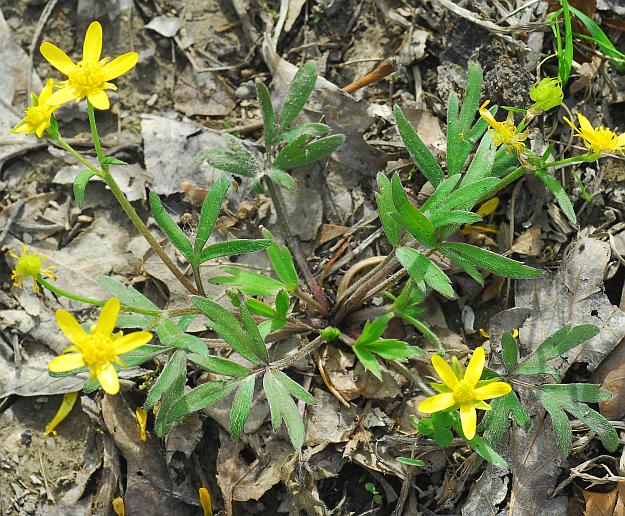Ranunculus fascicularis Muhl. ex Bigelow
Early Buttercup

Native
CC = 5
CW = 3
MOC = 62
© SRTurner
Ranunculus fascicularis Muhl. ex BigelowEarly Buttercup | |
 |
Native CC = 5 CW = 3 MOC = 62 |
© SRTurner |
|
Family - Ranunculaceae Habit - Perennial forb with a mixture of thin and fibrous and tuberous-thickened roots.
Stems - Erect or ascending, to 30 cm, not rooting at the lower nodes, moderately to densely pubescent with spreading and/or appressed hairs (especially toward the base), the base not bulbous-thickened. Leaves - Basal and alternate. Basal leaves long-petiolate, hairy, the petiole with a thin adaxial groove, the blade 1.5-5.5 cm long, 1-4 cm wide, ovate to broadly ovate in outline, pinnately compound, the earliest leaves sometimes merely deeply lobed, with 3 or 5 primary leaflets, these variously unlobed or 2-5-lobed or-parted, the ultimate lobes or segments linear to oblong, oblanceolate, or obovate, the base rounded to more commonly angled or tapered, the margins otherwise entire or occasionally few-toothed toward the tip. Stem leaves hairy, sessile to short-petiolate, the blade entire or shallowly to deeply 3-lobed or-divided, the segments linear to narrowly oblong or narrowly oblong-oblanceolate, the margins otherwise mostly entire.
Inflorescence - Single flowers terminating the long peduncles or sometimes the stalks branching. Peduncles hairy, to 20 cm long.
Flowers - Sepals 5, 5-7 mm long, spreading or reflexed from the base with age, lacking a transverse fold, planar. Petals 5 (occasionally more), 8-14 mm long, 3-6 mm wide, oblong, oblong-elliptic or narrowly oblong-ovate, longer than the sepals, yellow, glossy. Style present. Stamens numerous, ascending. Filaments yellowish, glabrous, thin at the base, expanded towards the apex. Carpels many, with long beaks, to 4 mm long in flower, glabrous. Receptacle pubescent at least at the apex.
Fruits - Head of achenes 5-9 mm long at maturity, globose to more or less ovoid, the receptacle glabrous or hairy. Achenes 2.0-2.8 mm long, turgid, the dorsal margin sharply angled, the wall thick, smooth, glabrous, the beak 1.2-2.8 mm long, slender, straight.
Flowering - February - May. Habitat - Dry and open upland woods, glades, prairies, savannas, pastures, lawns, farmyards, railroads, roadsides, most commonly on acidic substrates. Origin - Native to the U.S. Lookalikes - Other species of Ranunculus, especially R. hispidus, R. sardous. Other info. - This species of buttercup is found across much of Missouri, with the apparent exception of the northwestern third of the state. Within the U.S. its primary range is a north-south band through much of the Midwest, with more scattered populations reaching into New England and Canada. The glossy, bright yellow flowers easily mark this plant as a buttercup, but determination of specific identity requires a bit more examination. R. fascicularis is characterized by leaf lobes which tend to be long and narrow, with their tips bluntly pointed or rounded. The leaves also tend to have a canescent appearance (grayish due to hairiness). The thickened roots are also a strong clue, but one which should not be evaluated idly since it requires uprooting the plant. Other characters to verify include the prominent beak on the achenes and sepals which lack a well defined transverse fold. (For an example of the sharp sepal fold present in some members of the genus, see the sepal photo on the R. sardous page.) Photographs taken off 4-5-04 (DETenaglia); also at Washington State Park, Washington County, MO, 4-5-2010, 4-15-2014, and 4-18-2016, Kirkwood Park, St. Louis County, MO, 3-28-2019 and 4-2-2019, and at Drury-Mincy Conservation Area, Taney County, MO, 4-5-2019 (SRTurner). |